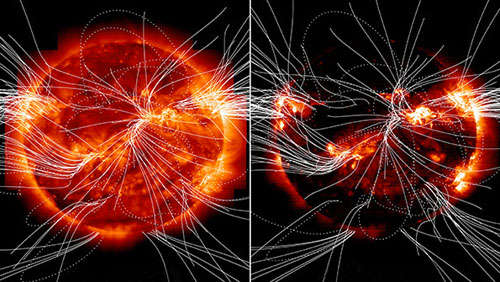
DENIZENS of Earth have a lot to thank the sun for. It is, after all, the ultimate source of almost all the energy on the planet, and thereby all the planet’s life. As part of the deal, the Earth gets a breeze from the solar wind, a stream of charged particles whizzing past that, among other effects, gives rise to the silent celestial light show known as the aurorae. Just what is going on to cause the wind, though, has been a focus of considerable study, and this week more answers have emerged.
From a physicist’s point of view, the solar wind is among the calmer of the phenomena near the sun’s surface. But as always in physics, it is all relative; this gentle breeze can come and go in gusts and gales, varies with latitude and carries on average about a trillion trillion trillion particles every second. What has confounded physicists the most, however, is that there appear to be two kinds of solar winds blowing: fast and slow. Here again, it is all relative: the slow solar wind wends its way outward at 400 kilometres per second, about a thousand times the speed of sound here on Earth. The fast solar wind moves at about twice that speed.
The two, it seems clear, come about in different locations and are due to different physical mechanisms. The fast stuff is actually the less variable, arising from regions in the sun’s corona (the cloud of hot, ionised gas that surrounds the sun proper and which is most apparent during an eclipse). At holes in the corona near the poles, magnetic field lines do not quite complete loops, permitting the charged particles to escape—a mix of elements from what is called the photosphere (nearer the surface of the sun itself—in a very real sense, it’s where the sun does shine). The denser, more turbulent slow wind, by contrast has a composition more like that of the corona, and its origin has remained a subject of some debate.
Scientists now seem to be closing in on an answer. David Brooks, of George Mason University, in Virginia, and his colleagues have snapped pictures of the entirety of the sun’s surface over 48 hours, using the Japanese satellite Hinode. The craft sports a camera that can see deep in the ultraviolet part of the spectrum. That is handy for differentiating the slow and fast winds, because their different constituent elements emit different colours of ultraviolet light when at the searing temperatures of a star’s surface.
Such pictures carry a great deal of information about speed, too; just like an approaching and then receding siren seems to shift in its frequency, winds moving toward or away from the satellite are shifted slightly in their apparent colour. The team’s programme of capturing the whole sun’s surface at one time permitted them not only to create full maps of the sun’s temperature, but also a full map of wind velocities. In a paper just published in Nature Communications, the team has matched these maps with their computer model of the magnetic fields present—permitting them, at long last, a good idea of just where the slow winds arise.
As yet, however, the exact sources are not certain; as is so often the case, further analysis is due before proclaiming success. That job will fall on the European Space Agency’s Solar Orbiter mission, scheduled for launch in mid-2017. Upon this satellite’s shoulders lies a fairly burdensome scientific question: how the sun creates and maintains its enormous sphere of influence, around the entirety of the solar system that it warms. That is a fairly tall order, but at least now the mission will have a map from which to start.
The economist

